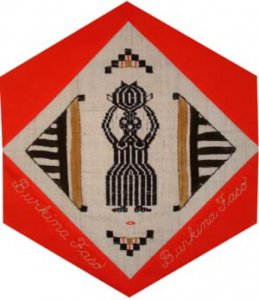Burkina Faso

The Block
Created from a piece of hand-woven cloth donated by Father Dakuo B. Pascal, the pattern features a stylized woman, carrying a basket of goods on her head. The side corners are made from mud cloth- a traditional African textile made by weaving long strips of cotton cloth, sewing them together to make panels, and applying dyes made from mud and leaves. The black weft stripes are a typical pattern found in West Africa as are the embroidered geometric designs enhancing the top and bottom corners of the piece.
Cultural Profile
Burkina Faso, which translates as ‘country of honest men,’ is a landlocked nation located in the heart of Western Africa. Once known as Upper Volta, this ‘Country of the Upright People’ is one of the smallest areas in West Africa and is in constant risk of drought. French is the official language, although tribal languages belonging to the Sudanic family are spoken by 90 percent of the population.
The people are known for their casual philosophy and have a reputation for being very hospitable. Respect is the cardinal value by which Burkinabè live. They are taught from a young age to respect their elders, to listen to their opinions and to seek their advice. Burkinabè are also very respectful to strangers, taking time to welcome them by inquiring about their culture and their life.
Burkina Faso has over 60 ethnic groups. The two principal are the Voltaic and the Mande. Each group has its own cultural values and structure. Even though most people belong either to the Muslim or the Christian faith, ancient rites are still valued and practiced. A distinctive element of Burkinabè culture includes their oral tradition, which is key in the preservation of their historic and cultural heritage. The djeli, known in the Western World as the griot, is the repository of this oral tradition.
Rhythm also plays a vital role in African life where music and dance are a means of entertainment as well as a form of expression. The djembe drums and the balafon, a wooden xylophone, are common instruments used in the country, with each ethnic group having their own varieties. The bendré drums, made of a large dried calabash, are also widely used while the kora, a 21-string harp (also made of dried gourd) is favored by djelis.
Performance and fine arts are greatly valued and the government organizes international and cultural events regularly. These include the International Arts and Crafts Show of Ouagadougou, which is the largest of its kind on the African continent, and the Pan-African Cinema and Television Festival of Ouagadougou.
National crafts include cowrie shell covered costumes and pottery. In fact, entire villages are made with clay and mud, such as the village of Tiébélé, where fascinating geometric designs decorate the curved walls of the houses. The Mossi, in particular, are known for their antelope masks that measure over two metres high and the Lobi for the wood carvings which protect the family and are highly valued. The Winiama make large masks used in performing mask dances to drive evil forces away from a community.
Textile arts include batik and tie-dye, often dyed with indigo as the plant grows easily in the area. Strip weaving is used to produce country cloth. The woven strips, each only a few inches wide, are stitched together to make cloth the desired width. Leather is also woven to produce horse reins, belts or straps and to produce bags and pouches.
Burkinabè are shown on immigration records as coming to Canada since 1975, but in small numbers. They came mainly for social and economic reasons, and a 2011 census indicates that there are just over 1,300 Burkinabè now living here.
Sponsor: Martintown Women’s Institute
